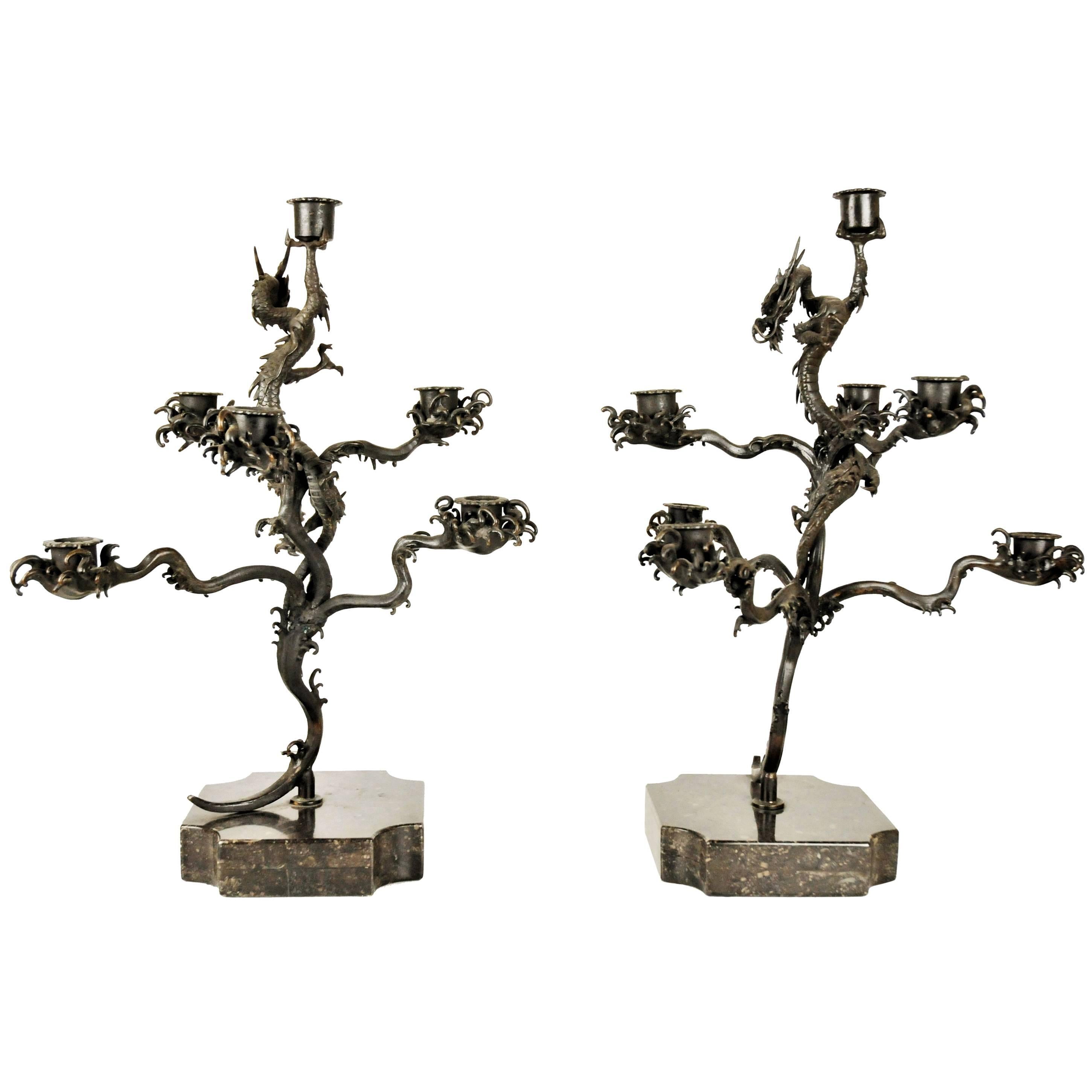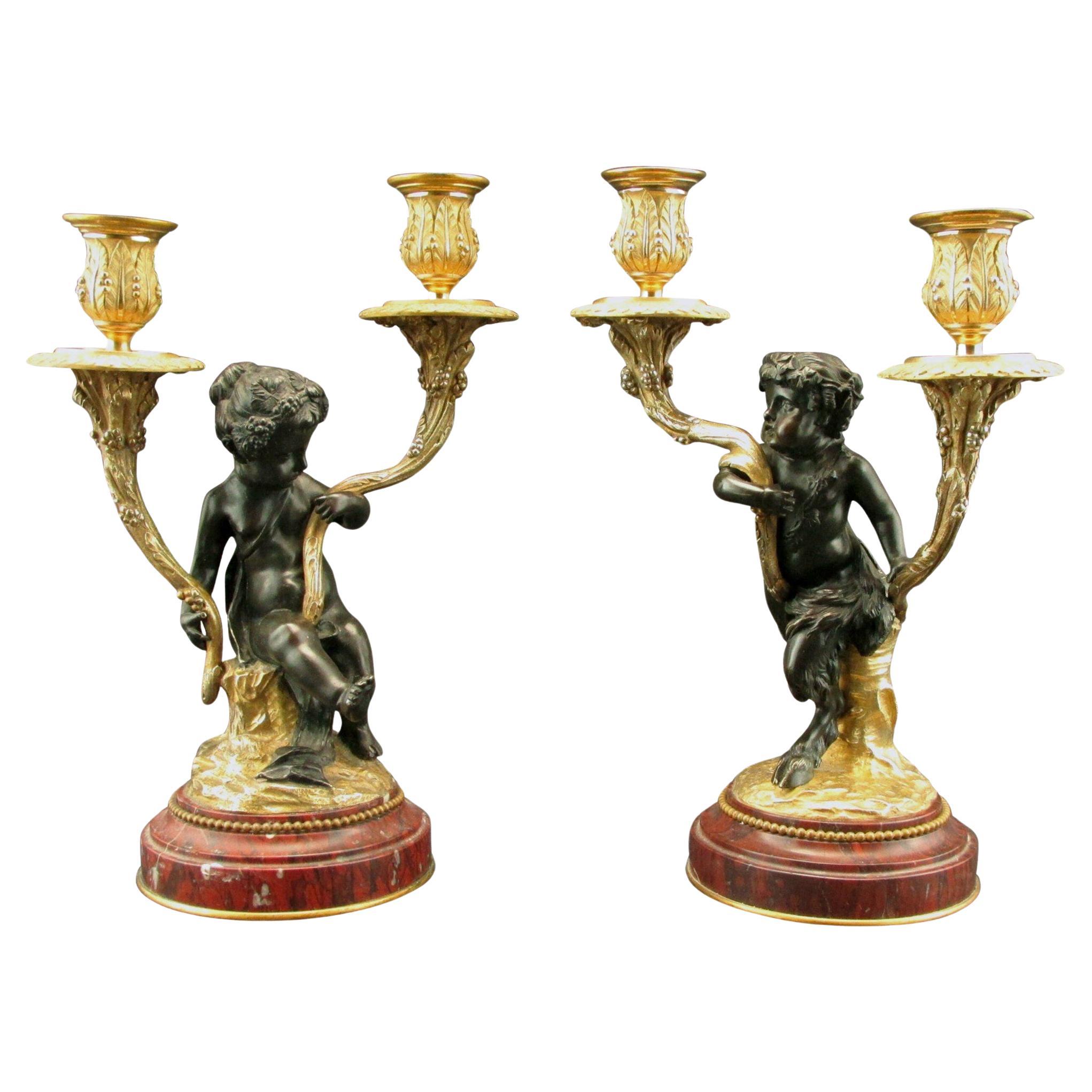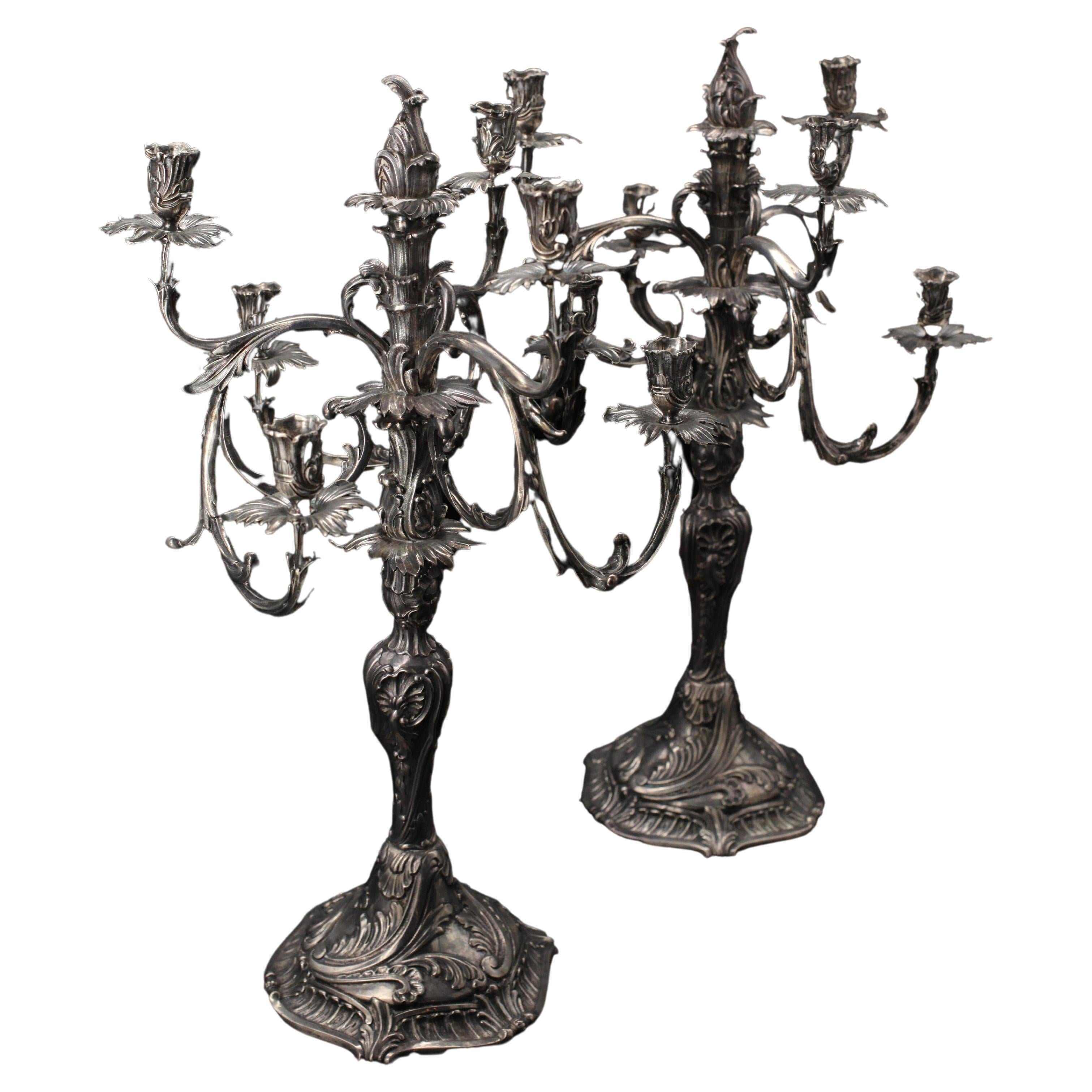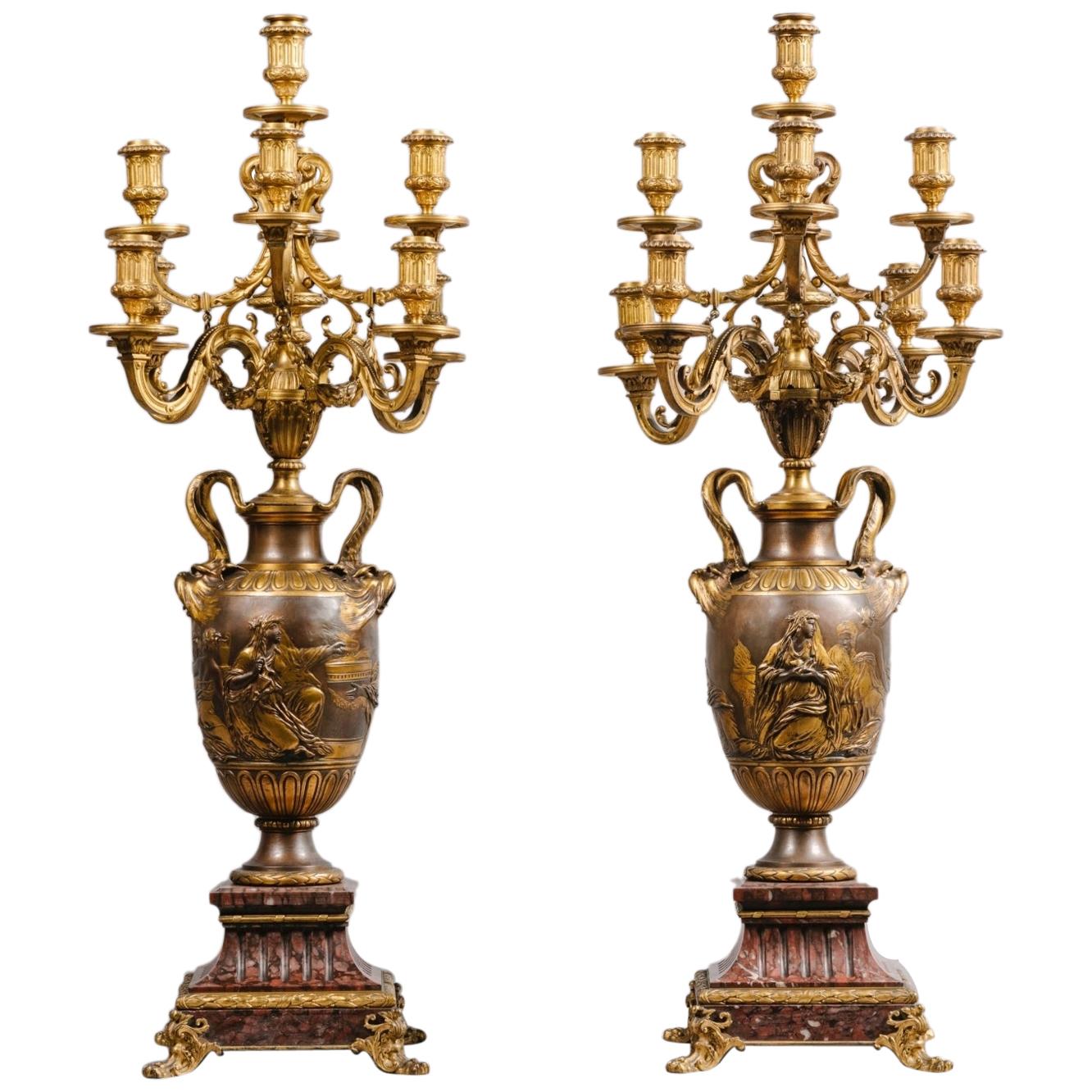Items Similar to Pair of American Rococo Revival Patinated Bronze Candelabras, Ca. 1825
Want more images or videos?
Request additional images or videos from the seller
1 of 12
Pair of American Rococo Revival Patinated Bronze Candelabras, Ca. 1825
About the Item
Bronze, dark-brown patina, unmarked.
Measures: Height: 23”
Width: 14”
The notion of an “American Rococo” seems a contradiction in terms. The very word rococo is as French as Camembert. It connotes a style that reigned along with Louis XV in the aristocratic decadence of the 18th Century. It was garlanded, nonchalant, associated with erotic marshmallow nudes by Francois Boucher and foppish courtiers costumed as shepherds pretending they understood Jean-Jacques Rousseau when all they really wanted was romantic dalliance in the formal gardens of Versailles. In the history of painting it produced but one great artist, Antoine Watteau.
By contrast, Americans of the period are remembered as the flinty inheritors of New England Puritans, full of rectitude and having not a moment for furbelow or frippery. Such few painters as were around included hard-nosed realists like John Singleton Copley and Charles Willson Peale.
Well, as it turns out, life once again acts according to the principle of paradox. There was an American rococo. It came to us indirectly via England disguised under the name Chippendale. Now for the first time the style receives comprehensive survey in the exhibition “American Rococo, 1750-1775: Elegance in Ornament.” Jointly organized by New York’s Metropolitan Museum and the Los Angeles County Museum of Art, it opens here Sundaywith a spread of some 170 works of decorative art and a conscientious catalogue with essays by Met and LACMA curators Morrison H. Heckscher and Leslie Greene Bowman.
There are at least two ways of looking at the decorative arts. Connoisseurs appreciate their design and craftsmanship. Those of sociological bent examine objects of material culture for their revelations of history and the temper of the times. Actually neither view is complete without the other.
Stylistically the rococo reveals a longing for intimacy in its small scale and an urge to organic nature in its love of stylized vines, tendrils, tiny flowers and seashells. If it were a new manner being promoted by Madison Avenue today it would probably be called “Baroque Lite.” There is an ease about the style that makes it airy, but it has an underlying formality that bespeaks lives of gentrified cultivation rather than beer-bellied sloth. It’s fascinating to examine the flintlock firearms on view and find these weapons of death shaped and decorated with the most exquisite care by wood carvers and metal engravers.
All of this is completely consistent with the main currents of 18th-Century European thought. In France, Rousseau sang the virtues of nature and the noble savage like a present-day ecologist. In England, John Locke spoke empirically of the social contract and the notion that government rests on popular consent. Locke was so revered here that his portrait was a standard subject for carved wood finials.
The rococo was, in a way, a sentimentalized blend of these two notions. When they were purified in the Enlightenment they led to the American Revolution and Jeffersonian Neoclassicism. Same thing happened in France. Their revolution trashed the picturesque and replaced it with Napoleonic revivalist Roman grandeur.
All that suggests linkage between one’s taste in interior decor and one’s politics. Turns out it doesn’t quite wash. In the American Colonies, everyone who could afford it was crazy about rococo and bought all they could, loyalists and rebels alike. The less economically fortunate had inexpensive bookplates and trade cards printed up to give them a touch of class--as witnessed by elaborate examples on view.
Paul Revere, who would gallop to warn the British were coming, was a renowned silversmith. He is represented in the exhibition by some lovely objects from a wedding service. They are the quintessence of restrained rococo lyricism.
Benjamin Franklin spent much time in London before the Revolution, representing colonial interests and his own fasciation with the Chippendale. He supervised the building of a new family house in Philadelphia at long distance, badgering his wife with letters instructing her how to get the rococo details just right.
Philadelphia was the hot pre-revolutionary town. It became the most venturesome and inventive in its use of the rococo. The gallery devoted to Philadelphia furniture bursts with barely restrained self-confidence. Case furniture features showy hardware, chests with elaborately carved architectural tops and imaginative sculptural wood finials. Upholstered pieces are covered with dramatic fabrics in daring shades of blue, green and buoyant yellow.
Without stock markets or banks, affluent colonials used real estate and household possessions as capital investments. Thus the economic vitality of a town could be more accurately gauged by the demeanor of its dwellings and furniture than is possible today.
Boston’s glory days were on the fade so its taste became cautious and conservative. New York was full of loyalists who fled with their rococo treasures or watched them destroyed when revolutionary occupation burned large sections of the city. All the same, there is one surviving serpentine New York card table on view that purely evokes the costumes and attitudes of the period.
“American Rococo” turns around a lot of notions about the revelatory values of decorative arts exhibitions. They are not just shows to be mined for ideas about how to redecorate the study. They are studies about how to rearrange ideas of history. Even the fine arts get nuanced reinterpretation from being exhibited with emphasis on the picture frames.
- Dimensions:Height: 23 in (58.42 cm)Width: 14 in (35.56 cm)Depth: 14 in (35.56 cm)
- Style:Rococo Revival (Of the Period)
- Materials and Techniques:Bronze,Patinated
- Place of Origin:
- Period:
- Date of Manufacture:circa 1825
- Condition:Wear consistent with age and use. We make our best effort to provide a fair and descriptive condition report. Please examine photos attentively, as they are part of the description. Send us a message to request more details or discuss price.
- Seller Location:New York, NY
- Reference Number:1stDibs: LU2819323260172
About the Seller
5.0
Vetted Seller
These experienced sellers undergo a comprehensive evaluation by our team of in-house experts.
Established in 1993
1stDibs seller since 2017
68 sales on 1stDibs
Typical response time: 2 hours
- ShippingRetrieving quote...Ships From: New York, NY
- Return PolicyA return for this item may be initiated within 10 days of delivery.
More From This SellerView All
- Pair of Japanese Patinated Bronze Candelabras, Meiji Period, ca. 1900Located in New York, NYThis most unusual pair of original 18th century Japanese patinated bronze candelabras, uniquely designed as branches of mountain flowers entangled by a dragon, are mounted on the con...Category
Antique Late 19th Century Japanese Japonisme Candelabras
MaterialsBronze
- French Art Nouveau Grand Bronze Iris Candelabra, ca. 1900Located in New York, NYABOUT IRIS MOTIFS Iris motifs were popular during the Arts & Crafts movement. The genus of this easy-to-stylize flower has nearly 300 varieties that bloom in many colors—thus its nam...Category
Antique Early 1900s French Art Nouveau Candelabras
MaterialsBronze
- A Pair of Bronze Neoclassical Grand Tour Candelabras, Late 19th CenturyLocated in New York, NYGrand Tour Pair of Bronze Candelabras Late 19th Century DIMENSIONS Height: 10.33 inches Width: 4.75 inches Depth: 4.75 inches ABOUT We present to your attention a pair of stunning...Category
Antique 1890s English Grand Tour Candelabras
MaterialsBronze
- Aesthetic Movement Pair of Bronze Candlesticks in Manner of Tiffany, ca. 1880sLocated in New York, NYAmerican Aesthetic Movement Pair of Bronze Candlesticks in Manner of Tiffany ca. 1880s DIMENSIONS Height: 18.25 inches Width: 3.25 inches Depth: 3.25 inches ABOUT This elegant pa...Category
Antique 1880s American Aesthetic Movement Candlesticks
MaterialsBronze
- Head of a Jazzman, Patinated Bronze Sculpture, American, ca. 1940sLocated in New York, NYAbout sculpture This remarkable portrait bust is in all likelihood a privately commissioned sculpture from around 1940s. Despite the fact that the sculpture is not signed, it is cer...Category
Vintage 1940s American Streamlined Moderne Busts
MaterialsBronze
- Cannonball Thrower, American Modernist Patinated Bronze Sculpture, ca. 1960Located in New York, NYDefinitely created by a master sculptor, this small but very dynamic modernist sculpture depicts a cannonball thrower in the moment of forceful rotation before the actual throw of th...Category
Mid-20th Century American Mid-Century Modern Abstract Sculptures
MaterialsBronze
You May Also Like
- Pair of Rococo Revival Ormolu Three-Light CandelabraLocated in Brighton, West SussexA Pair of Louis XV Style Rococo Revival Ormolu Three-Light Candelabra. Finely cast in the Rococo Revival style this fine pair of English candelabra...Category
Antique 19th Century English Rococo Revival Candelabras
MaterialsOrmolu
- Pair of Patinated and Polished Bronze Renaissance Revival CandelabraLocated in Hudson, NYThis pair of candelabra made in France, circa 1880 are designed in the Renaissance Revival style. Well cast in a large number of separate parts and patinated and polished to create drama and decorative detail the pair is of a nice scale without being overly large. Cast as a central column raised on a pyramidal pierced base. The base is centered by grotesque masks and foliate sprays raised up on feet. The shaft leads up to four large branched arms also cast with corresponding foliate sprays issuing from more grotesques. The combination of color and casting create a lively play of light. Condition Disclosure: While we do our best to carefully inspect and give a full report on the condition of any item we sell, pointing out any repairs or alterations that may have been done to the best of our knowledge, as is the case with any antique and vintage item, there is a possibility that at some point in the life of the piece that there may have been damaged which has been professionally repaired and as such a repair undetectable, it is therefore impossible for us to disclose... we recommend that you also read and agree to the 1st dibs user agreement...Category
Antique Late 19th Century Renaissance Revival Candelabras
MaterialsBronze
- Superior Pair of 19th Century Patinated & Parcel Gilt Bronze Figural CandelabraBy Claude Michel ClodionLocated in Ottawa, OntarioAn exceptionally fine pair of 19th century patinated & parcel gilt bronze figural candelabra, executed in the Rococo manner closely associated with works by Claude Michel (Clodion) 1...Category
Antique Late 19th Century French Rococo Revival Candelabras
MaterialsMarble, Bronze
- Pair Michelsen Rococo Style Sterling CandelabraBy Anton MichelsenLocated in Austin, TXDip into Rococo reverie and illuminate your surroundings with the dazzling duo of Sterling Candelabras by Anton Michelsen. With their every Rococo-inspired detail, they stand as sile...Category
20th Century Danish Rococo Revival Candelabras
MaterialsSterling Silver
- Pair of Patinated Bronze Nine-Light Candelabra by BarbedienneBy Ferdinand BarbedienneLocated in Brighton, West SussexA fine pair of neoclassical style gilt and patinated bronze nine-light candelabra by Ferdinand Barbedienne, French, Circa 1870.Category
Antique 19th Century French Neoclassical Revival Candelabras
MaterialsBronze
- Pair Antique French Charles X Gold Bronze & Patinated Bronze Candelabra, Ca 1880Located in New Orleans, LAPair Antique French Charles X Gold Bronze & Patinated Bronze candelabra, Circa 1880.Category
Antique 19th Century French Charles X Candelabras
MaterialsBronze
Recently Viewed
View AllMore Ways To Browse
Philadelphia Furniture
Philadelphia Used Furniture
Bronze Ca
Antique Wood Finials
Table Candelabra
Blue Rococo
Dining Room Table Candelabra
Large American Bronze
Revival American
Bronze Rococo
Revival House
England Rococo
Candelabra Shades
Flower Candelabra
Flower Candelabras
Small Candelabra
Rococo Style Art
Used Furniture Los Angeles Ca





